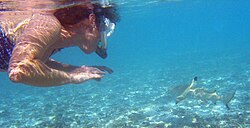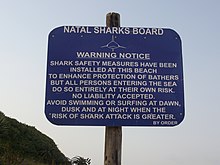Attacks

Snorkeler swims near blacktip reef shark. In rare circumstances involving poor visibility, blacktips may bite a human, mistaking it for prey. Under normal conditions they are harmless and shy.
Contrary to popular belief, only a few sharks are dangerous to humans. Out of more than 360 species, only four have been involved in a significant number of fatal, unprovoked attacks on humans: the great white, oceanic whitetip, tiger, and bull sharks. These sharks, are large, powerful predators, and may sometimes attack and kill people. Despite being responsible for attacks on humans they have all been filmed without using a protective cage.
The perception of sharks as dangerous animals has been popularized by publicity given to a few isolated unprovoked attacks, such as the Jersey Shore shark attacks of 1916, and through popular fictional works about shark attacks, such as the Jaws film series. Jaws author Peter Benchley in his later years attempted to dispel the image of sharks as man-eating monsters.
In captivity
Until recently only a few benthic species of shark, such as hornsharks, leopard sharks and catsharks had survived in aquarium conditions for a year or more. This gave rise to the belief that sharks, as well as being difficult to capture and transport, were difficult to care for. More knowledge has led to more species (including the large pelagic sharks) living far longer in captivity. At the same time, safer transportation techniques have enabled long distance movement. One shark that never had been successfully held in captivity for long was the great white. But in September 2004 the Monterey Bay Aquarium successfully kept a young female for 198 days before releasing her.Most species are not suitable for home aquaria and not every species sold by pet stores are appropriate. Some species can flourish in home saltwater aquaria. Uninformed or unscrupulous dealers sometimes sell juvenile sharks like the nurse shark, which upon reaching adulthood is far too large for typical home aquaria. Public aquaria generally do not accept donated specimens that have outgrown their housing. Some owners have been tempted to release them. Species appropriate to home aquaria represent considerable spatial and financial investments as they generally approach adult lengths of 3 feet and can live up to 25 years.
In Hawaii
Sharks figure prominently in Hawaiian mythology. Stories tell of men with shark jaws on their back who could change between shark and human form. A common theme was that a shark-man would warn beach-goers of sharks in the waters. The beach-goers would laugh and ignore the warnings and get eaten by the shark-man who warned them. Hawaiian mythology also includes many shark gods. Among a fishing people, the most popular of all aumakua, or deified ancestor guardians, are shark aumakua. Kamaku describes in detail how to offer a corpse to become a shark. The body transforms gradually until the kahuna can point the awe-struck family to the markings on the shark's body that correspond to the clothing in which the beloved's body had been wrapped. Such a shark aumakua becomes the family pet, receiving food, and driving fish into the family net and warding off danger. Like all aumakua it had evil uses such as helping kill enemies. The ruling chiefs typically forbade such sorcery. Many Native Hawaiian families claim such an aumakua, who is known by name to the whole community.Kamohoali'i is the best known and revered of the shark gods, he was the older and favored brother of Pele, and helped and journeyed with her to Hawaii. He was able to assume all human and fish forms. A summit cliff on the crater of K?lauea is one of his most sacred spots. At one point he had a heiau (temple or shrine) dedicated to him on every piece of land that jutted into the ocean on the island of Moloka'i. Kamohoali'i was an ancestral god, not a human who became a shark and banned the eating of humans after eating one herself. In Fijian mytholog, Dakuwanga was a shark god who was the eater of lost souls.


0 comments:
Post a Comment